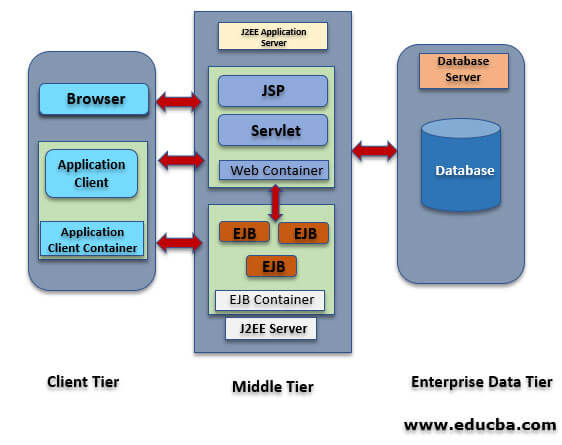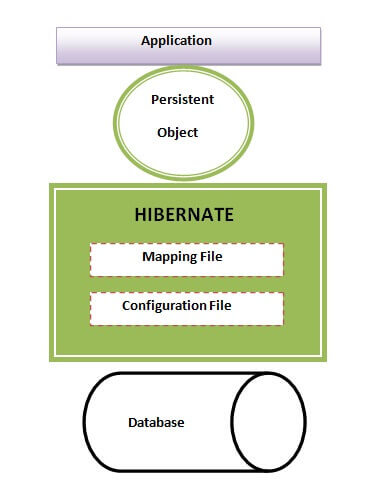Java Technical Architect Interview QuestionsA Java Technical Architect is responsible for achieving an organization's goal by defining, integrating, and upgrading a complete architecture to support Java applications. In this section, we will discuss roles and responsibilities, necessary skills, and interview questions for the Java Technical Architect profile. Java Technical Architect SkillsTo become a Java Technical Architect, one should have the following skills:
RequirementsThe following are some basic requirements for Java Technical Architect Job:
Roles and ResponsibilitiesJava Architect roles and responsibilities are as following:
Top 20 Interview Questions for Java Technical Architect1) Explain the Architecture of Java J2EE?J2EE is Java 2 Enterprise Edition that provides a convenient way for developing and implementing Java enterprise applications. The J2EE architecture is a three-tiered architecture, which are client, Middle, and enterprise data tier. The Client Tier is an interactive medium used to interact with the client or user. It consists of web clients and application clients. The Middle Tier defines the functioning units. The Data Tier is meant for storage purposes. It is used in the form of a relational database, containers, components, and services. 
Specifically, the J2EE architecture consists of four tiers; the client, web, enterprise Java Bean, and enterprise information tier, but the middle tier holds two Web+ EJB tiers. 2) What is the ETL process?ETL stands for Extract, Transfer, and Load. It is a process to extract data from multiple resources, then transfer it by performing the operations such as concatenations, calculations, etc., and load it into a data warehouse system. In this process, we need active inputs from various stakeholders such as developers, analysts, testers, etc. It is a technically challenging process. 3) What is Functional Programming in Java?Java supports functional programming. Since Java 8, we can use Lambda expression for functional programming. We can also use code to declare the functional paradigm. Functional programming is a programming approach in which computations can be coded as functions. These functions are mathematical functions called the lambda function. The functional programming is declarative, which means we do not need to describe the control flow of a computation logic. The below program implements the functional programming in Java using a lambda expression: Test.java: Output: In Runnable thread In main thread In the above program, we have achieved the functional programming using Java 8. we can also do the same by using the anonymous method. We have evaluated a function and assigned it to a runnable interface. Now, this function has been treated as a first-class citizen. So this is the basic concept of functional programming. 4) Explain the difference between JDBC and HibernateThe JDBC ( Java Database Connectivity) is a programming interface that creates a connection between Java application and database. It establishes a link between the Java program and database so that we can send the data from the Java code and store it in our database. Hibernate is an open-source ORM (Object Relational Mapping) framework. It allows us to develop the objects which are independent of the database tool and creates independent persistence logic. Basically, It simplifies the interaction process between Java applications and databases. It implements JPA(Java Persistence API). 5) Explain The Hibernate ArchitectureThe Hibernate architecture consists of the following four layers:

6) What are some essential elements of Hibernate Architecture?The following are the elements of Hibernate Architecture:
SessionFactory The SessionFactory holds the session objects. It contains the second-level data cache( optional). It uses the org.hibernate.SessionFactory interface to provide a factory method to access the session object. Session The session object acts as a medium between the application and database. It provides an interface to the application to access the stored data from the database. The session object is a short-lived object and encloses the JDBC connection. It is a factory of the different elements of the session such as Query, transaction, criteria. It holds the first-level data cache (mandatory). The org.hibernate.Session interface provides methods to insert, update and delete the object. Furthermore, it provides factory methods for Transaction, Query, and Criteria. Transaction The transaction objects contain the atomic unit of the tasks. It is an optional element. The org.hibernate.Transaction interface provides methods for transaction management. ConnectionProvider The ConnectionProvider provides JDBC connections. It is an optional element. It abstracts the application from DriverManager or DataSource. TransactionFactory The TransactionFactory is an optional element. It holds the transaction objects. 7) If a Database Deadlock occurs, then how would you deal with it?The Deadlock is a situation when multiple requests are tried to acquire its lock. To prevent the database from going into this state, we will make a queue to verify each request before forwarding it to the database. Besides the above mention strategy, we can also follow the below strategies:
8) What would be better to store session info or using the session info in the request?To store the session info would be better than using the session info in the request. Because using the session info in the request can be intercepted and vulnerable. A cookie can be accessed by the respective domain only and ensures that the right session information is passed by the user. 9) Differentiate the first level and second level cache in HibernateThe first level cache is maintained at the session level and can be accessed only to the session. Comparatively, the second-level cache is maintained at the SessionFactory level and available for all the sessions. 10) How to Avoid the Lazyinitializationexception?Follow the below steps to avoid the Lazyinitializationexception in Java:
11) What is LambdaExpression in Java?Java supports LambdaExpression since Java 8. It is a type of short block code which takes in parameters and returns a value. Lambda expressions are much similar to methods; the difference between methods and Lambda Expression is that we do not need to write its name; instead, we can implement them right in a method's body. The basic syntaxes for the lambda expression are as follows: 12) Explain the Advantages of Using the Lambda ExpressionsThe following are some key advantages of using the lambda expression:
13) What are the Remote Procedure Calls (RPC)?The RPC or remote procedure calls are the interprocess communication technique that is used in client-based web applications. They are also known as subroutine calls or function calls. When a client made a request, RPC translates it and sends it to the server. Usually, these requests are function calls or a procedure to the remote server. When the server gets a request, it responds back to the client; the client is blocked during this process, only resumed when the server completes its execution. 14) What are the benefits of using Spring Framework in Java?Spring is a powerful Java framework for developing enterprise Java applications. The following are some key benefits of using the Spring framework:
15) What is Database Sharding?Sharding is a process to make the partition the data in database or search engine. In this process, the data is divided into small chunks or shards. The shard can be a table. Postgres schema or a database held on a database server instance. 16) What are the web services?The Web Services are the client and server applications that communicate over the internet using the HTTP protocol. They provide a convenient mechanism to interoperate between software applications and frameworks. We can also understand web services as methods of communication between two devices. See more about Web Services. 17) Explain the difference between SOAP Services and Rest Services?SOAP stands for Simple Object Access Protocol while Rest stands for Representational State Transfer. The SOAP is a protocol that was designed before the idea of the Rest; it is mainly used to ensure that the programs can easily transfer the data over different platforms and programming languages. Comparatively, Rest is designed for working with media components, files, and objects on a particular device. The services which are designed using the REST principles are called RestFul web services. See more about the Soap Vs. Rest. 18) Why Web services use HTTP as the communication protocol?HTTP is the most preferred way of communicating over the web. Nowadays, most applications are designed in a way to communicate through the HTTP protocol. So using web services with the HTTP makes applications accessible from a wide variety of applications. 19) What is the difference between HTTP and HTTPs?The HTTPs is the extended version of the HTTP protocol. The major difference between HTTP and HTTPs is the SSL certificate. The HTTPs provides additional security to the application. The HTTPs becomes very useful for those web applications that keep the sensitive information of the user, such as credit card details. See more about HTTP vs. HTTPS. 20) Explain the working of TCP/IP.The TCP/IP model was developed to provide efficient and accurate data transmission between devices. It breaks a message into several small packets to avoid transmission failure in a long size file. In case it encounters a problem during the transmission, it will start sending the packets again from where they break and reassembles the packets at the destination port. Every route can take a different route to reach the destination. Thus, it provides a secure and uninterrupted data transmission. Read more about the TCP/IP protocol. Conclusion:In this section, we have discussed top 20 questions of Java that will be useful for your Java Technical Architect Interview. A Java Technical Architect is responsible for dealing with the different SDLC sections. |
You may also like:
- Java Interview Questions
- SQL Interview Questions
- Python Interview Questions
- JavaScript Interview Questions
- Angular Interview Questions
- Selenium Interview Questions
- Spring Boot Interview Questions
- HR Interview Questions
- C Programming Interview Questions
- C++ Interview Questions
- Data Structure Interview Questions
- DBMS Interview Questions
- HTML Interview Questions
- IAS Interview Questions
- Manual Testing Interview Questions
- OOPs Interview Questions
- .Net Interview Questions
- C# Interview Questions
- ReactJS Interview Questions
- Networking Interview Questions
- PHP Interview Questions
- CSS Interview Questions
- Node.js Interview Questions
- Spring Interview Questions
- Hibernate Interview Questions
- AWS Interview Questions
- Accounting Interview Questions







